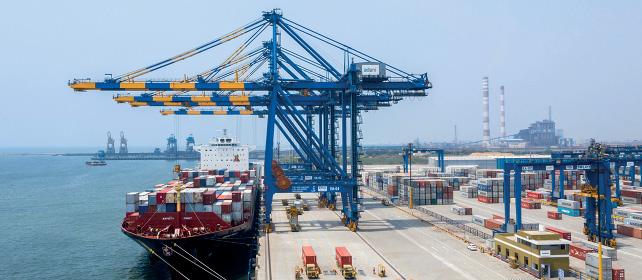
4 minute read
Indian legislation
ONE STEP FORWARD, ONE BACK?
Two new Bills herald major reforms to the Indian ports sector but when looked at overall does it amount to “one step forward and one step back?” AJ Keyes takes a detailed look
The Central Government of India has recently delivered one new ports bill - the Major Port Authorities Bill 2021 – and has a second in the pipeline, the Draft Indian Ports Bill, 2021 which covers the country’s so-called minor ports.
Ports in India are classified as either major ports or minor ports. While the major ports fall under the jurisdiction of the central government, the minor ports are owned and managed by state governments.
The major ports in the country are in Chennai, Cochin, Mumbai (Jawaharlal Nehru Port), Kandla, Kochi, Kolkata, Mumbai, New Mangalore, Mormugao, Paradip, Tuticorin and Visakhapatnam.
Each major port is governed by a board of trustees, appointed by the government, but operating through policy directives and executive orders from the Indian government of India. Crucially, the tariffs for all major ports are fixed by the Tariff Authority for Major Ports (TAMP).
The Ministry of Ports, Shipping, and Waterways confirms that there are around 200 minor ports in the country. All are managed at the state level, by the state government or State Maritime Boards.
The changes implemented and proposed have more than a little irony associated with them
WHAT IS THE MAJOR PORT AUTHORITIES BILL 2021?
The Major Port Authorities Bill 2021 was approved by the Parliament in India in February 2021. It has a very simple aim of wanting to amend the management model of these major ports in the country, which, it can be argued, is to support further privatisation.
The Bill has a clear and defined objective of decentralising power by allowing for the creation of a “Board of Major Port Authority” for each of these major ports – and in doing so, the existing government-appointed port trusts will be removed.
Moreover, the board for each major port will have to include representatives from the state government, such as the Ministry of Railways, Ministry of Defence, Ministry of Customs, and the Department of Revenue as members. There will also be one member nominated by the government, plus a representative of the employees.
According to the Ministry of Ports, Shipping and Waterways, the Major Ports Trust Act of 1963 was deemed to be restrictive and the country’s major ports are, “finding it difficult to operate in a highly competitive environment and be able to respond to market challenges”.
The newly passed Major Port Authorities Act 2021 provides all major ports with an increased level of autonomy. Crucially, the boards of each port will gain the power to establish rates and charges in accordance with underlying market conditions – and compete directly with private competitors. This includes a major dilution of the role of the much criticised Tariff Authority for Major Ports (TAMP).
WHAT IS THE DRAFT INDIAN PORTS BILL 2021?
The second legislative change to the port industry is the Draft Indian Ports Bill, 2021. It proposes to alter the existing management system for minor ports away from current jurisdiction of state governments or state maritime boards.
The Bill also seeks to provide increased opportunities for public and private investments in the Indian maritime and ports sector.
A further objective is to enable the central advisory body, the Maritime States Development Council (MSDC), authority to plan, develop, and control minor ports, plus cover all administrative and financial functions. These are all powers that are currently undertaken by state governments.
In a Government statement, the following was confirmed: “The up-to-date provisions of the proposed Bill would ensure safety, security, pollution control, performance standards and sustainability of ports.” Clearly, this will enable the MSDC to develop a national plan to develop and benefit the maritime sector.
REGISTERING DISSENT
The Draft Indian Ports Bill, 2021, has met widespread opposition from the coastal states of Gujarat, Andhra Pradesh, Tamil Nadu, and Odisha, protesting about the proposed dilution of their authority over the minor ports, which drive the states’ economies.
M. K. Stalin, Chief Minister of Tamil Nadu, produced a letter in June that urged the chief ministers of nine coastal states to “register their dissent” against the draft Bill because many powers currently exercised by state governments would be lost. “This move of the Central government to bring a new Bill will have long-term adverse implications on the management of minor ports, since the State Governments will not have any major role anymore, if the Bill is passed.”
Change looks evident at both major and minor ports in India, although the government looks to have a fight on its hands to convince all parties concerned that the new legislation will be the best outcome especially with the Draft Indian Ports Bill, 2021. The point is made how the major ports’ share of cargo moved has fallen from 92 per cent in 1993-94 to 54 per cent in 2020-21, but the non-major ports’ share has gone up from 8 per cent to 46 per cent over the same period. Under the current regime, non-major ports are expected to overtake major ports in the immediate future.
Anyone familiar with the Indian port scene might be forgiven for thinking this represents ‘one step forward and one step back’. Freedom for major ports to set tariffs is a real step forward and will boost investment prospects, but placing minor ports under central control will increase bureaucracy and move investments further away from local needs. This is all the more surprising with the significant progress achieved under the decentralised model.
8 Major ports in










